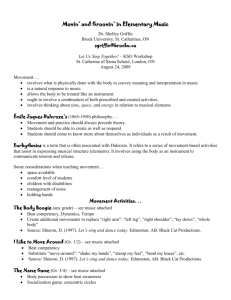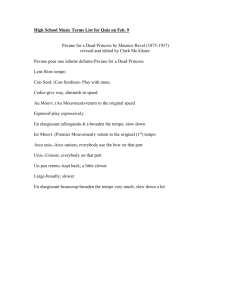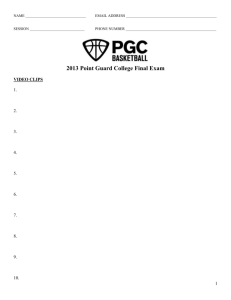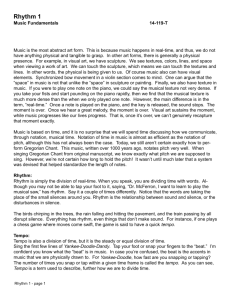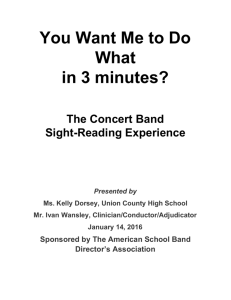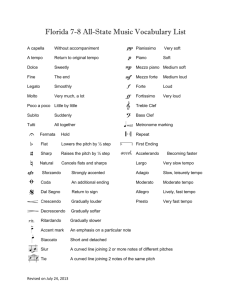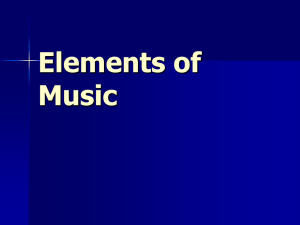TEMPO AND BEAT ESTIMATION OF MUSICAL SIGNALS ENST-GET, D´epartement TSI
advertisement
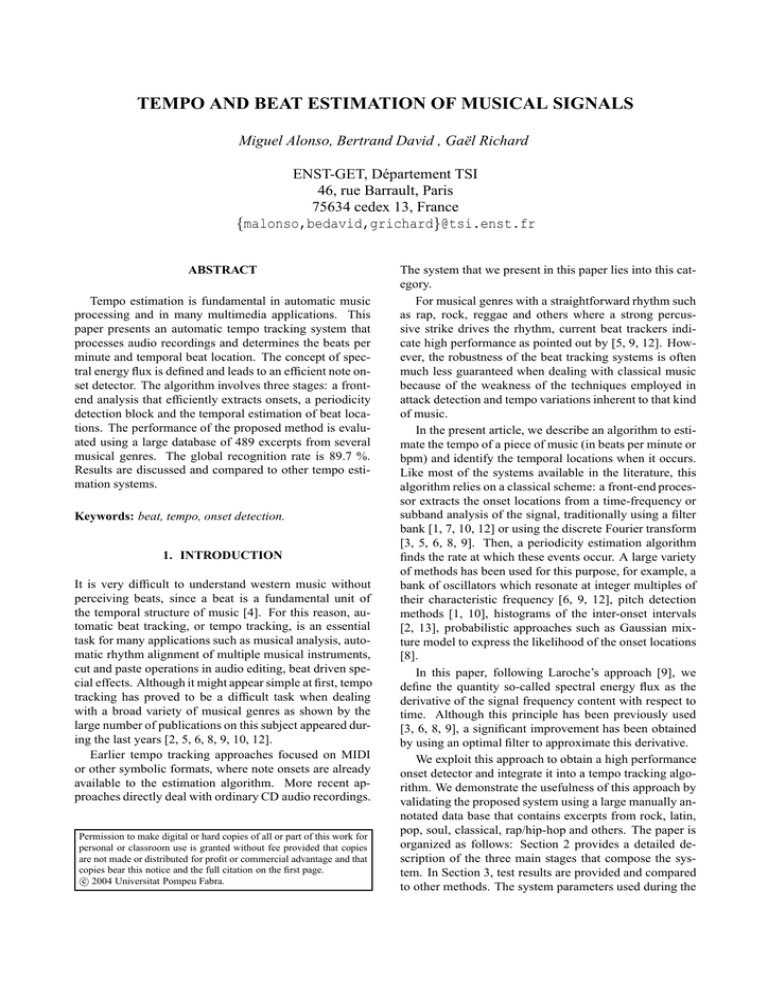
TEMPO AND BEAT ESTIMATION OF MUSICAL SIGNALS
Miguel Alonso, Bertrand David , Gaël Richard
ENST-GET, Département TSI
46, rue Barrault, Paris
75634 cedex 13, France
{malonso,bedavid,grichard}@tsi.enst.fr
ABSTRACT
Tempo estimation is fundamental in automatic music
processing and in many multimedia applications. This
paper presents an automatic tempo tracking system that
processes audio recordings and determines the beats per
minute and temporal beat location. The concept of spectral energy flux is defined and leads to an efficient note onset detector. The algorithm involves three stages: a frontend analysis that efficiently extracts onsets, a periodicity
detection block and the temporal estimation of beat locations. The performance of the proposed method is evaluated using a large database of 489 excerpts from several
musical genres. The global recognition rate is 89.7 %.
Results are discussed and compared to other tempo estimation systems.
Keywords: beat, tempo, onset detection.
1. INTRODUCTION
It is very difficult to understand western music without
perceiving beats, since a beat is a fundamental unit of
the temporal structure of music [4]. For this reason, automatic beat tracking, or tempo tracking, is an essential
task for many applications such as musical analysis, automatic rhythm alignment of multiple musical instruments,
cut and paste operations in audio editing, beat driven special effects. Although it might appear simple at first, tempo
tracking has proved to be a difficult task when dealing
with a broad variety of musical genres as shown by the
large number of publications on this subject appeared during the last years [2, 5, 6, 8, 9, 10, 12].
Earlier tempo tracking approaches focused on MIDI
or other symbolic formats, where note onsets are already
available to the estimation algorithm. More recent approaches directly deal with ordinary CD audio recordings.
Permission to make digital or hard copies of all or part of this work for
personal or classroom use is granted without fee provided that copies
are not made or distributed for profit or commercial advantage and that
copies bear this notice and the full citation on the first page.
c 2004 Universitat Pompeu Fabra.
The system that we present in this paper lies into this category.
For musical genres with a straightforward rhythm such
as rap, rock, reggae and others where a strong percussive strike drives the rhythm, current beat trackers indicate high performance as pointed out by [5, 9, 12]. However, the robustness of the beat tracking systems is often
much less guaranteed when dealing with classical music
because of the weakness of the techniques employed in
attack detection and tempo variations inherent to that kind
of music.
In the present article, we describe an algorithm to estimate the tempo of a piece of music (in beats per minute or
bpm) and identify the temporal locations when it occurs.
Like most of the systems available in the literature, this
algorithm relies on a classical scheme: a front-end processor extracts the onset locations from a time-frequency or
subband analysis of the signal, traditionally using a filter
bank [1, 7, 10, 12] or using the discrete Fourier transform
[3, 5, 6, 8, 9]. Then, a periodicity estimation algorithm
finds the rate at which these events occur. A large variety
of methods has been used for this purpose, for example, a
bank of oscillators which resonate at integer multiples of
their characteristic frequency [6, 9, 12], pitch detection
methods [1, 10], histograms of the inter-onset intervals
[2, 13], probabilistic approaches such as Gaussian mixture model to express the likelihood of the onset locations
[8].
In this paper, following Laroche’s approach [9], we
define the quantity so-called spectral energy flux as the
derivative of the signal frequency content with respect to
time. Although this principle has been previously used
[3, 6, 8, 9], a significant improvement has been obtained
by using an optimal filter to approximate this derivative.
We exploit this approach to obtain a high performance
onset detector and integrate it into a tempo tracking algorithm. We demonstrate the usefulness of this approach by
validating the proposed system using a large manually annotated data base that contains excerpts from rock, latin,
pop, soul, classical, rap/hip-hop and others. The paper is
organized as follows: Section 2 provides a detailed description of the three main stages that compose the system. In Section 3, test results are provided and compared
to other methods. The system parameters used during the
2.1.1. Spectral analysis and spectral energy flux
Audio Signal
Onset detection
− Spectral analysis (STFT)
− Spectral energy flux
Synchronised
beat signal
Beat
location
Detection
function
Periodicity
estimation
The input audio signal is analyzed using a decimated version of the short-time Fourier transform (STFT), i.e., short
signal segments are extracted at regular time intervals, multiplied by an analysis window and transformed into the
frequency domain by means of a Fourier transform. This
leads to
N−1
X̃( f , m) =
∑ w(n)x(n + mM)e− j2π f n
(1)
n=0
validation procedure are provided as well as comments
about the issues of the algorithm. Finally, Section 4 summarizes the achievements of the presented algorithm and
discusses possible directions for further improvements.
where x(n) denotes the audio signal, w(n) the finite analysis window of size N in samples, M the hop size in samples, m the frame index and f the frequency.
Motivated by the work of Laroche [9], we define the
spectral energy flux E( f , k) as an approximation to the
derivative of the signal frequency content with respect to
time
2. DESCRIPTION OF THE ALGORITHM
E( f , k) = ∑ h(m − k) G( f , m)
Figure 1. Architecture of the beat tracking algorithm.
In this paper, it is assumed that the tempo of the audio signal is constant over the duration of the analysis window
and that it eventually evolves slowly from one to the other.
In addition, we suppose that the tempo lies between 60
and 200 BPM, without loss of generality since any other
value can be mapped into this range. The algorithm proposed is composed of three major steps (see figure 1):
• onset detection: it consists in computing a detection
function based on the spectral energy flux of the input audio signal;
• periodicity estimation : the periodicity of the detection function is estimated using pitch detection
techniques ;
• beat location estimation : the position of the corresponding beats is obtained from the cross-correlation
between the detection function and an artificial pulsetrain.
2.1. Onset detection
The aim of onset detection consists in extracting a detection function that will indicate the location of the most
salient features of the audio signal such as note changes,
harmonic changes and percussive events. As a matter of
fact, these events are particularly important in the beat perception process.
Note onsets are easily masked in the overall signal energy by continuous tones of higher amplitude [9], while
they are more likely detected after separating them in frequency channels. We propose to follow a frequency domain approach [3, 5, 6, 8, 9] as it proves to outperform
time-domain methods based on direct processing of the
temporal waveform as a whole.
(2)
m
where h(m) approximates a differentiator filter with:
H(e j2π f ) ' j2π f
(3)
and the transformation
G( f , m) = F {|X̃( f , m)|}
(4)
is obtained via a two step process: a low-pass filtering of
|X̃( f , m)| to perform energy integration in a way similar to
that in the auditory system, emphasizing the most recent
inputs, but masking rapid modulations [14] and a nonlinear compression. For example, in [9] Laroche proposes
h(m) as a first order differentiator filter (h = [1; −1]), no
low-pass filtering is applied and the non-linear compression function is G( f , n) = arcsinh(|X̃( f , m)|). In [6] Klapuri uses the same first order differentiator filter, but for
the transformation, he performs the low-pass filtering after applying a logarithmic compression function.
In the present work we propose h(m) to be a FIR filter
differentiator. Such a filter is designed by a Remez optimisation procedure which leads to the best approximation to
Eq. (3) in the minimax sense [11]. This new approach,
compared to the first order difference used in [6, 8, 9]
highly improves the extraction of musical meaningful features such as percussive attacks and chord changes. In
addition, G( f , k) is obtained via low-pass filtering with
a second half of a Hanning window followed by a logarithmic compression function as suggested by Klapuri [7],
since the logarithmic difference function gives the amount
of change in a signal in relation to its absolute level. This
is a psycho-acoustic relevant measure since the perceived
signal amplitude is in relation to its level, the same amount
of increase being more prominent in a quite signal [7].
During the system development, several orders for the
differentiator filter h(m) were tested. We found that using
an order 8 filter was the best tradeoff between complexity and efficiency. In practice, the algorithm uses an N
θ(k) = C · median(gk )
(5)
where gk = {vk − i, . . . , vk , . . . , vk + i } and C is a predefined scaling factor to artificially rise the threshold curve
slightly above the steady state level of the signal. To ensure accurate detection, the length of the median filter
must be longer than the average width of the peaks of
the detection function. In practice, we set the median filter length to 200 ms. Then, we obtain the signal p̂(k) =
v(k) − θ(k), which is half-wave rectified to produce the
detection function p(k):
p(k) =
p̂(k)
0
if p̂(k) > 0
otherwise
(6)
In our tests, the onset detector described above has proved to be a robust scheme that provides good results for a
wide range of musical instruments and attacks at a relatively low computational cost. For example, Figure 2-a
shows the time waveform of a piano recording containing
seven attacks. These attacks can be easily observed in the
signal’s spectrogram in Figure 2-b. The physical interpretation of Figure 2-c can be seen as the rate at which the
frequency-content energy of the audio signal varies at a
given time instant, i.e., the spectral energy flux. In this example, seven vertical stripes represent the reinforcement
of the energy variation, clearly indicating the location of
the attacks (the position of the spectrogram edges). When
all the positive energy variations are summed in the frequency domain and thresholded, we obtain the detection
function p(k) shown in Figure 2-d. An example of an instrument with smooth attacks, a violin, is shown in Figure
3. Large energy variations in the frequency content of the
audio signal can still be observed as vertical stripes in Figure 3-c. After summing the positive contributions, six of
the seven attacks are properly detected as shown by the
corresponding largest peaks in Figure 3-d.
a) amplitude
1
0
c) frequency (kHz) b) frequency (kHz)
-1
d) magnitude
point FFT to evaluate the STFT, thus the frequency channels 1 to N2 of the signal’s time–frequency representation
are filtered using h(m) to obtain the spectral energy flux.
Then, all the positive contributions of these channels are
summed to produce a temporal waveform v(k) that exhibits sharp maxima at transients and note onsets, i.e.,
those instants where the energy flux is large.
Beat tends to occur at note onsets, so we must first distinguish the ”true beat” peaks from the spurious ones in
v(k) to obtain a proper detection function p(k). In addition, we work under the supposition that these unwanted
peaks are much smaller in amplitude compared to the note
attack peaks. Thus, a peak-picking algorithm that selects
peaks above a dynamic threshold calculated with the help
of a median filter is a simple and efficient solution to this
problem. The median filter is a nonlinear technique that
computes the pointwise median inside a window of length
2i + 1 formed by a subset of v(k), thus the median threshold curve is given by the expression:
0
1
2
3
4
0
0
1
2
3
4
0
1
2
3
4
0
1
2
3
4
1
1
0
1
0.5
0
time (s)
Figure 2. From top to bottom: time waveform of a piano
signal, its spectrogram, its spectral energy flux and the detection function p(k).
2.2. Periodicity estimation
The detection function p(k) at the output of the onset detection stage can be seen as a quasi-periodic and noisy
pulse-train that exhibits large peaks at note attacks. The
next step is to estimate the tempo of the audio signal, i.e.,
the periodicity of the note onset pulses. Two methods
from traditional pitch determination techniques are employed: the spectral product and the autocorrelation function. These techniques have already been used for this
purpose in [1].
2.2.1. Spectral product
The spectral product principle assumes that the power spectrum of the signal is formed from strong harmonics located at integer multiples of the signal’s fundamental frequency. To find this frequency, the power spectrum is
compressed by a factor m, then the obtained spectra are
multiplied, leading to a reinforced fundamental frequency.
For a normalized frequency, this is given by:
S(e j2π f ) =
M
∏ |P(e j2πm f )|
m=1
for f <
1
2M
(7)
where P(e j2π f ) is the discrete Fourier transform of p(k).
Then, the estimated tempo T is easily obtained by picking
out the frequency index corresponding to the largest peak
of S(e j2π f ). The tempo is constrained to fall in the range
60 < T < 200 BPM.
Genre
classical
jazz
latin
pop
rock
reggae
soul
rap, hip-hop
techno
other
total
a) amplitude
1
0
d) magnitude
c) frequency (kHz) b) frequency (kHz)
-1
0
1
2
3
4
5
0
1
2
3
4
5
2
1
0
Pieces
137
79
37
40
44
30
24
20
23
55
489
Percentage
28.0 %
16.2 %
7.6 %
8.2 %
9.0 %
6.1 %
4.9 %
4.1 %
4.7 %
11.2 %
100 %
2
1
0
Table 1. Genre distribution of the test database.
0
1
2
0
1
2
3
4
3
4
1
0.5
0
5
time (s)
Figure 3. From top to bottom: time waveform of a violin signal, its spectrogram, its spectral energy flux and the
detection function p(k).
location, i.e., ti = bti−1 + T c and a corresponding peak in
p(k) is searched within the area ti ± ∆. If no peak is found,
the beat is placed in its expected position ti . When the last
beat of the window occurs, its location is stored in order
to assure the continuity with the first beat of the new analysis window. Where the tempo of the new analysis window differs by more than 10 % from the previous tempo, a
new beat phase is estimated. The peaks are searched using
the new beat period without referencing the previous beat
phase.
3. PERFORMANCE ANALYSIS
2.2.2. Autocorrelation function
3.1. Database, annotation and evaluation protocole
This is a classical method in periodicity estimation. The
non-normalized deterministic autocorrelation function of
p(k) is calculated as follows:
r(τ) = ∑ p(k + τ)p(k)
(8)
k
Again, we suppose that 60 < T < 200 BPM. Hence, during the calculation of the autocorrelation, only the values
of r(τ) corresponding to the range of 300 ms to 1 s are
calculated. To find the estimated tempo T, the lag of the
three largest peaks of r(τ) are analyzed and a multiplicity
relationship between them is searched. In the case that no
relation is found, the lag of the largest peak is taken as the
beat period.
2.3. Beat location
To find the beat location, we use a method based on the
comb filter idea that resembles previous work carried out
by [6, 9, 12]. We create an artificial pulse-train q(t) of
tempo T previously calculated as explained in Section 2.2
and cross-correlate it with p(k). This operation has a low
computational cost, since the correlation is evaluated only
at the indices corresponding to the maxima of p(k). Then,
we call t0 the time index where this cross-correlation is
maximal and we consider it as the starting location of the
beat. For the second and succesive beats in the analysis
window, a beat period T is added to the previous beat
The proposed algorithm was evaluated using a corpus of
489 musical excerpts taken from commercial CD recordings. These pieces were selected to cover as many characteristics as possible: various tempi in the 50 to 200
BPM range, a wide variety of instruments, dynamic range,
studio/live recordings, old/recent recordings, with/without
vocals, male/female vocals and with/without percussions.
They were also selected to represent a wide diversity of
musical genres as shown in Table 1.
From each of the selected recordings, an excerpt of 20
seconds having a relatively constant tempo, was extracted
and converted to a monophonic signal sampled at 16 kHz.
The procedure for manually estimating the tempo of each
musical piece is the following:
• the musician listens to a musical excerpt using headphones (if required, several times in a row to be accustomed to the tempo),
• while listening, he/she taps the tempo,
• the tapping signal is recorded and the tempo is extracted from it.
As pointed out by Goto in [4], the beat is a perceptual
concept that people feel in music, so it is generally difficult to define the ”correct beat” in an objective way. People have a tendency to tap at different metric levels. For
Method
Paulus [10]
Scheirer [12]
SP .
AC .
SP using SEF.
AC using SEF
Recognition
rate
56.3 %
67.4 %
63.2 %
73.6 %
84.0 %
89.7 %
Table 2. Tempo estimation performances. SEF stands for
spectral energy flux, SP for spectral product and AC for
autocorrelation.
example, in a piece that has a 4/4 time signature, it is correct to tap every quarter-note or every half-note. In general, a ”ground truth” tempo cannot be established unless
the musical score of the piece is available. This is a very
common problem when humans tap along with the music, i.e., to tap twice as fast or twice as slow the ”true”
tempo. Whenever this case ocurred during the database
annotation, the slower tempo was taken as reference TR .
In a similar way to humans, automatic tempo estimation
methods also make this doubling or halving of the ”true”
tempo. Thus, for evaluation purposes the tempo estimation T provided by the algorithm is labeled as correct if
there is a less than 5% disagreement from the manually
annotated tempo used as reference TR under the principle
0.95αT < TR < 1.05αT with α ∈ { 12 , 1, 2}.
3.2. Results
During the evaluation, the algorithm parameters were set
as follows. The length of the analysis window for tempo
estimation was set to four seconds, with an overlapping
factor of 50%. Smaller window size values reduce the
algorithm performance. For the spectral energy flux calculation, the length of the analysis window used in the
computation of the STFT was 64 samples (4 ms) with an
overlapping factor of 50% and a 128 point FFT, thus the
detection function v(k) could be seen as signal sampled at
500 Hz. As mentioned, the order of the differentiator FIR
filter was set to L = 8. In the beat location stage, the median filter i was set to 25 samples, C was set to 2, and for
the peak location ∆ was set to 10 % of the beat period.
To have a better idea of the performance of our algorithm, we decided to compare it with our own implemententation of the algorithms proposed by Paulus [10]
and Scheirer [12]. We also compared it with our previous
work in tempo estimation [1]. In this case, the main difference between the previous and the current system lies on
the onset extraction stage. Table 2 summarizes the overall
recognition rate for the evaluated systems. In this table,
SP stands for spectral product, AC for autocorrelation and
SEF for spectral energy flux.
In more details, the performance of these methods by
musical genre are presented in Table 3. In this table, PLS
stands for Paulus, SCR for Scheirer. As expected, results
Method
Genre
classical
jazz
latin
pop
rock
reggae
soul
rap
techno
other
PLS
%
46.0
57.0
70.3
57.5
40.9
76.7
50.0
75.0
69.6
61.8
SCR
%
46.2
70.9
81.1
70.0
84.1
86.7
87.5
85.0
56.3
69.1
SP
%
48.2
62.0
62.1
75.0
61.3
86.6
70.8
75.0
65.2
74.5
AC
%
70.8
69.8
70.3
85.7
84.4
76.9
76.7
56.5
95.0
66.7
SP-SEF
%
71.5
78.4
91.8
92.5
81.8
96.6
100
100
95.6
89.0
AC-SEF
%
82.4
86.0
94.5
92.5
88.6
100
100
100
100
90.9
Table 3. Tempo estimation performances by musical
genre. PLS stands for Paulus [10], SCR for Scheirer [12].
indicate that classical music is the most difficult genre.
Nevertheless, the proposed algorithm displayed promising
results. For the other genres, it shows good performance,
particularly for music with a straightforward rhythm.
Several authors have pointed out the difficulty in evaluating beat tracking systems [4, 6, 9] due to the subjective
interpretation of the beat and the inexistence of a consensual data base of beat-labeled audio tracks. In our case,
the beat location evaluation was done at a subjective level,
that is, artificial ”sound clicks” were superimposed on the
tested signal at the calculated beat locations and tempo.
During the validation procedure, we note that the proposed algorithm produces erroneous results under the following circumstances:
• when dealing with signals having a stealthily or long
fading-in attacks, the hypothesis that supurious peaks
are smaller than attack peaks does not hold any more,
leading to false onset detections;
• the spectral energy flux follows the principle that
stable spectra regions are followed by transition regions. When many instruments play simultaneously,
as in an orchestra, their ’spectral mixture’ lacks stable regions, leading to false onset detections;
• when the tempo varies too quickly in short time segments or if there are large beat gaps in the signal, the
periocity estimation stage cannot keep up with the
changes.
The reader is welcome to listen to the sound examples
available at www.tsi.enst.fr/∼malonso/ismir04.
4. CONCLUSIONS
In this paper we have presented an efficient beat tracking algorithm that processes audio recordings. We have
also defined the concept of spectral energy flux and used
it to derive a new and effective onset detector based on the
STFT, an efficient differentiator filter and dynamic thresholding using a median filter. This onset detector displays
high performance for a large range of audio signals. In
addition, the proposed tempo tracking system is straightforward to implement and has a relatively low computational cost. The performance of the algorithm presented
was evaluated on a large database containing 489 musical excerpts from several musical genres. The results are
encouraging since the global success rate for tempo estimation was 89.7%. The method presented works offline. A real-time implementation is considered, but currently there are various issues to be resolved such as the
block-wise processing that requires access to future signal samples and the non-causality of the thesholding filter. Future work should explore other periodicity estimation techniques and an analysis of the residual part after a
harmonic/noise decomposition.
5. REFERENCES
[1] Alonso M., David B. and Richard G., ”A
Study of Tempo Tracking Algorithms from
Polyphonic Music Signals”, Proceedings of
the 4th. COST 276 Workshop, Bordeaux,
France. March 2003.
[2] Dixon, M. ”Automatic Extraction of Tempo
and Beat from Expressive Performances”,
Journal of New Music Research,vol. 30 No. 1,
pp. 39–58 2001.
[3] Duxbury C., Sandler M. and Davies M., ”A
Hybrid Approach to Musical Note Onset Detection”, Proceedings of the 5th. Int. Conf.
on Digital Audio Effects (DAFx), pp. 33–38,
Hamburg Germany, September 2002.
[4] Goto M. and Muraoka Y. ”Issues in Evaluating
Beat Tracking Systems”, Working Notes of the
IJCAI-97 Workshop on Issues in AI and Music,
August 1997.
[5] Goto, M. ”An Audio-based Real-time Beat
Tracking System for Music With or Without Drum-sounds”, Journal of New Music Research, vol. 30, No. 2, pp. 159–171, 2001.
[6] Klapuri, A. ”Musical meter estimation and
music transcription”, Cambridge Music Processing Colloquium, Cambridge University,
UK, March 2003.
[7] Klapuri, A. ”Sound Onset Detection by Applying Psychoacoustic Knowledge”, Proceedings IEEE Int. Conf. Acoustics Speech and Sig.
Proc. (ICASSP), pp. 3089–3092, Phoenix AR,
USA March 1999.
[8] Laroche, J. ”Estimating, Tempo, Swing and
Beat Locations in Audio Recordings”, Proceedings IEEE Workshop on Applications of
Signal Processing to Audio and Acoustics
(WASPAA), pp. 135–138, New Paltz, NY, USA
October 2001.
[9] Laroche, J. ”Efficient Tempo and Beat Tracking in Audio Recordings”, J. Audio. Eng. Soc.,
vol. 51, No. 4, pp. 226–233, April 2003.
[10] Paulus J. and Klapuri A., ”Measuring the Similarity of Rythmic Patterns”, Proceedings of
the International Symposium on Music Information Retrieval, Paris, France, 2002.
[11] Proakis, J. G. and Manolakis, D., Digital Signal Processing: Principles, Algorithms and
Applications. Prentice Hall, New York, 1995.
[12] Scheirer, E. D., ”Tempo and Beat Analysis of
Acoustic Music Signals”, J. Acoust. Soc. Am.,
vol. 104, pp. 588–601, January 1998.
[13] Seppa anen, J. ”Tatum grid analysis of musical
signals”, Proceedings IEEE Workshop on Applications of Signal Processing to Audio and
Acoustics (WASPAA), New Paltz, NY, USA
October 2001.
[14] Todd, N. P. McA., ”The Auditory ’Primal
Sketch’: A Multiscale model of rhythmic
grouping”, Journal of New Music Research,
vol. 23, No. 1, pp. 25 – 70, 1994.
